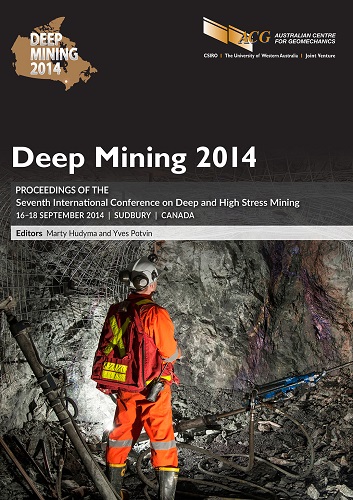Economic and productivity comparison of ground support for rockburst-prone and squeezing ground conditions

|
Authors: Hayman, LJ |
DOI https://doi.org/10.36487/ACG_rep/1410_22_Hayman
Cite As:
Hayman, LJ 2014, 'Economic and productivity comparison of ground support for rockburst-prone and squeezing ground conditions', in M Hudyma & Y Potvin (eds), Deep Mining 2014: Proceedings of the Seventh International Conference on Deep and High Stress Mining, Australian Centre for Geomechanics, Perth, pp. 329-342, https://doi.org/10.36487/ACG_rep/1410_22_Hayman
Abstract:
Rockbursting and squeezing ground conditions in hard rock underground mines worldwide cause mine workers to be exposed to high consequence workplace hazards and have major economic implications. Designing ground support to withstand the anticipated ground conditions is one method of controlling these risks. A rockburst is defined as damage to an excavation that occurs in a sudden and violent manner and is associated with a mining-induced seismic event, and may cause an unacceptable workplace hazard (Kaiser & Cai 2013). Additionally, large scale deformations in drives, or squeezing ground conditions in hard rock underground mines have major economic implications. In 254 rockburst cases analysed worldwide by Heal (2010), the most common component of the integrated ground support system to fail was the surface support. It has also been suggested by Hadjigeorgiou et al. (2013) that squeezing ground cannot be stopped but can be controlled by ground support which is able to “deform in order to accommodate the resulting high deformations while maintaining the integrity of the reinforced rock unit” (Potvin & Hadjigeorgiou 2008). The Australian Centre of Geomechanics (ACG) has developed, over seven years a high energy absorption mesh (HEA Mesh) which is designed to withstand a larger amount of quasi-static and dynamic loading due to rockbursting and squeezing ground than regular weld mesh. It consists of a sheet of weld mesh reinforced with a cable around the sheet perimeter and interlocking in two ‘V’ shapes in the middle. The design was based upon the South African cable lacing method, but with the installation time of weld mesh, to combine strength and flexibility. Preliminary laboratory and field testing results indicate that the HEA Mesh included in a dynamic ground support system performs better than ground support that is commonly used currently for rockbursting and squeezing ground conditions. Underground operations have been reluctant to adopt this mesh due to lack of awareness of the product. The literature will be used as a foundation to present laboratory and field test results of the HEA Mesh. Three case studies of Australian and European underground mining operations will be analysed for cost-benefit of incorporating HEA Mesh into their current rockburst and squeezing ground support. Incorporation of the HEA Mesh was assessed and quantified to provide apparent cost savings in three currently operating underground mines. These study results offer a number of advantages to operations worldwide, including improved productivity and safety. In the current Australian mining climate specifically, cost savings would be extremely beneficial.
References:
Australian Centre for Geomechanics 2008, Long Shaft Site 3 Simulated Rockburst Results, report from the Mine Seismicity and Rockburst Risk Management Project, ACG, Perth.
Heal, D 2010, ‘Observations and Analysis of Incidences of Rockburst Damage in Underground Mines’, PhD thesis, The University of Western Australia, Perth.
Kaiser, PK, Tannant, DD, McCreath, DR & Jesenak, P 1992, ‘Rockburst Damage Assessment Procedure’, in PK Kaiser & DR McCreath (eds), Rock Support in Mining and Underground Construction, A.A. Balkema, Rotterdam, pp. 639-647.
Morton, EC, Thompson, AG, & Villaescusa, E 2009, ‘The performance of mesh, shotcrete and membranes for surface ground support’, in M Diederichs & G Grasselli (eds), Proceedings of the 3rd CANUS Rock Mechanics Symposium: ROCKENG09, paper 4022.
Potvin, Y & Hadjigeorgiou, J 2008, ‘Ground Support Strategies to Control Large Deformations in Mining Excavations’, The Journal of the Southern African Institute of Mining and Metallurgy, vol. 108, pp. 393-400.
Stacey, TR and Ortlepp, WD 2001 ‘Tunnel surface support — capacities of various types of wire mesh and shotcrete under dynamic loading’, Journal of the South African Institute of Mining and Metallurgy, vol. 101, no. 7, pp. 337-342.
© Copyright 2025, Australian Centre for Geomechanics (ACG), The University of Western Australia. All rights reserved.
View copyright/legal information
Please direct any queries or error reports to repository-acg@uwa.edu.au
View copyright/legal information
Please direct any queries or error reports to repository-acg@uwa.edu.au